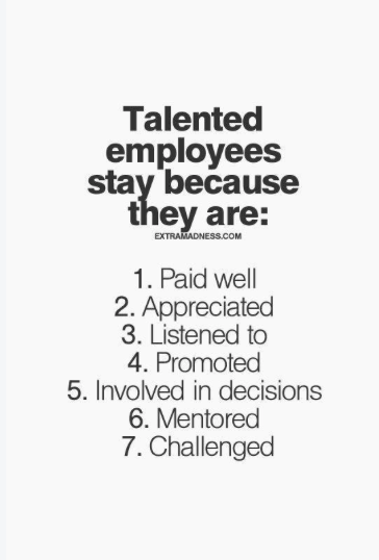Look after the water and the fish will look after themselves
Leadership Blog | 6 minute read

Written by Sara Moore

Creating the context for talent retention
A couple of weeks ago I came across the above LinkedIn post listing the seven reasons talented employees choose to stay with an organisation. As the post points out, they have little to do with parties or free lunches. What they do suggest is that recognition, being listened to and being challenged are important. There is nothing in the list that I’d disagree with and hats off to Community of Seven for posting and creating the discussion around these vital elements. However, I can’t help but think that there’s something missing. Where do values and purpose fit in the mix?
The full list starts, unsurprisingly with being paid well, followed by being listened to; appreciated; promoted; involved in decisions; mentored; and finally, challenged. Undoubtedly many organisations can and should do better on these basic factors. It is certainly possible that many forget these principles as they rush to offer more ‘trendy’ perks like duvet days and free fruit. But looking more closely two things occurred to me. The context in which these factors operate is as important as the actions themselves, and values and purpose are fundamental to the creation of that context. Let me explain.
No water, no fish
Context is the invisible environment which influences how an organisation, thinks, acts and is. A simple analogy makes this clear; if the seven factors listed above were fish in an aquarium, the context would be the water in the tank. You don’t see it or normally pay attention to it, but without it there would be no fish. Understanding the decisive role of context in shaping the cultures, behaviours and expectations of people in an organisation is critical to effectiveness and to retaining those talented people.
Values and purpose work to shape the context. Individuals elect to join and remain with organisations that share their values. The way they act and the way they are as a collective build the unspoken, and often invisible set of expectations and ways of being that form the context to everything that happens in the organisation. Authentic cultures are clear and transparent on the context they create - making alignment, commitment, retention and satisfaction easier to achieve. Disaffection, disillusionment and departure occur when the gap between espoused values and actual context becomes too wide.
Indicators not activators
Re-examining the list from the perspective of context they can be seen not as things that can be activated to improve retention, but as indicators of misalignment that maybe causing more deep- seated issues. The fact that employees rate these factors as important perhaps highlights them as the inflection points where stated values and reality diverge most frequently.
Creating an authentic culture that avoids this misalignment is more important that trying to micro-manage each of the factors. Leaders should focus on the water as well as the fish. They need to be aware of their role in shaping culture and expectations. An organisation that commits to values of collaboration and empowerment will set a higher bar for ‘being listened to’ and ‘involved in decisions.’ Leaders need to live up to these values personally and be sure that they influence actions and decisions throughout the business. Pay, recognition, mentoring etc can all be dialled up and down almost endlessly, but unless the levels of each factor are aligned with the values of the business the overall environment will falter.
Clear Water
What constitutes the healthiest water in the aquarium will be different for every organisation. Some will value discipline and loyalty above questioning and innovation, others will promise flat organisation and personalised development. It does not matter what the values are, what’s important is the authentic alignment of values and purpose between the organisation and its employees.
The role of the leader is to look after the water in the aquarium. The fish in it, the factors listed by Community of Seven, are the litmus tests that demonstrate the health of the ecosystem. By investing in clarity of the water and ensuring that actions and behaviours are aligned to the potential of that environment, leaders will better meet the expectations of employees.
So, whilst these seven factors are clearly important to employees, leaders are well advised to think about the context in which these things matter. Creating alignment, being transparent and authentic about values and purpose, and ensuring that daily actions, decisions and behaviours are completely attuned to them is fundamentally the best way to retain talent. Worrying about the water rather than the fish will not only keep the fish alive but create a healthy environment for growth.
Published 25/03/2021
Subscribe by Email
Achieve more breakthroughs. Get expert leadership ideas, insights and advice straight to your inbox every Saturday, as well as the occasional bit of news on us, such as offers and invitations to participate in things like events, webinars and surveys. Read. Lead. Breakthrough.
Tags
- Hiring
- Change management
- Organisational culture
- Leadership development
- Team development
- Behaviour change
- Decision making
- Attracting talent
- Developing talent
- Organisational development
- Retaining talent
- Employee engagement
- Motivating people
- Organisational values & purpose
- Strategy execution
- Strategic thinking
- Strategy
- Performance management
- Managing people
- Developing middle management
- High performing teams
- Productivity
- Innovation
- Communication
- Mindset
- Breakthrough Thinking
- Developing millennials
- Human Resource Management
- Career planning
Related posts
Leadership Blog
Leadership burnout: Expanding bandwidth to thrive through complexity
Achieve Breakthrough | 16/12/2025
Leadership Blog
What triggers you as a leader, and how to work with it?
Achieve Breakthrough | 09/12/2025
Leadership Blog
Why it’s impossible to lead with one foot still in your old role
Achieve Breakthrough | 03/12/2025
Leadership Blog
Why a leader’s true value lies in what they enable, not just what they know
Achieve Breakthrough | 25/11/2025

